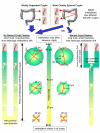Tracing ancestry with methylation patterns: most crypts appear distantly related in normal adult human colon
- PMID: 15059289
- PMCID: PMC400737
- DOI: 10.1186/1471-230X-4-8
Tracing ancestry with methylation patterns: most crypts appear distantly related in normal adult human colon
Abstract
Background: The ability to discern ancestral relationships between individual human colon crypts is limited. Widely separated crypts likely trace their common ancestors to a time around birth, but closely spaced adult crypts may share more recent common ancestors if they frequently divide by fission to form clonal patches. Alternatively, adult crypts may be long-lived structures that infrequently divide or die.
Methods: Methylation patterns (the 5' to 3' order of methylation) at CpG sites that exhibit random changes with aging were measured from isolated crypts by bisulfite genomic sequencing. This epigenetic drift may be used to infer ancestry because recently related crypts should have similar methylation patterns.
Results: Methylation patterns were different between widely separated ("unrelated") crypts greater than 15 cm apart. Evidence for a more recent relationship between directly adjacent or branched crypts could not be found because their methylation pattern distances were not significantly different than widely separated crypt pairs. Methylation patterns are essentially equally different between two adult human crypts regardless of their relative locations.
Conclusions: Methylation patterns appear to record somatic cell trees. Starting from a single cell at conception, sequences replicate and may drift apart. Most adult human colon crypts appear to be long-lived structures that become mosaic with respect to methylation during aging.
Figures




References
-
- Bristol JB, Williamson RC. Large bowel growth. Scand J Gastroenterol Suppl. 1984;93:25–34. - PubMed
-
- Potten CS, Loeffler M. Stem cells: Attributes, cycles, spirals, pitfalls and uncertainties. Lessons for and from the crypt. Development. 1990;110:1001–1020. - PubMed
-
- Maskens AP, Dujardin-Loits RM. Kinetics of tissue proliferation in colorectal mucosa during post-natal growth. Cell Tissue Kinet. 1981;14:467–477. - PubMed
Publication types
MeSH terms
Grants and funding
LinkOut - more resources
Full Text Sources

